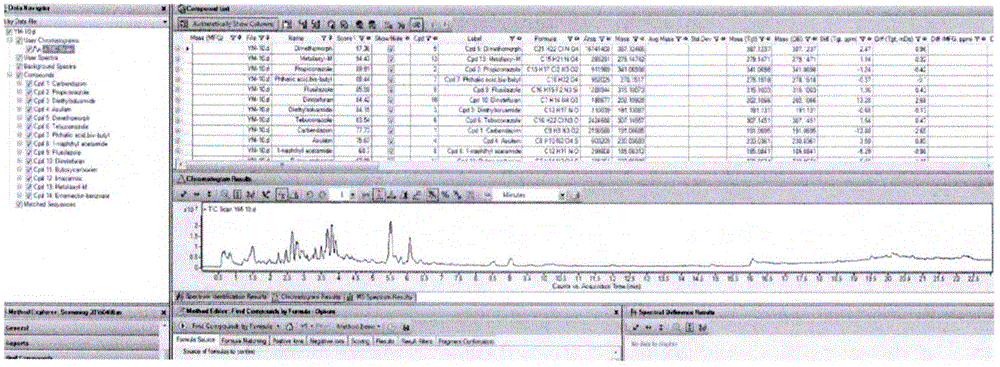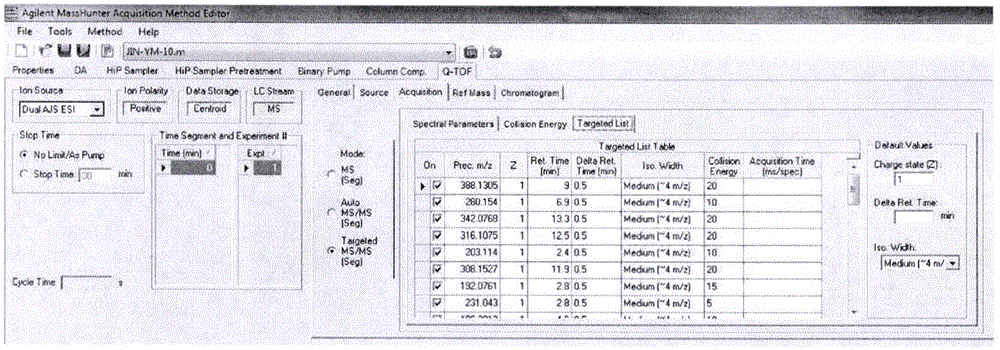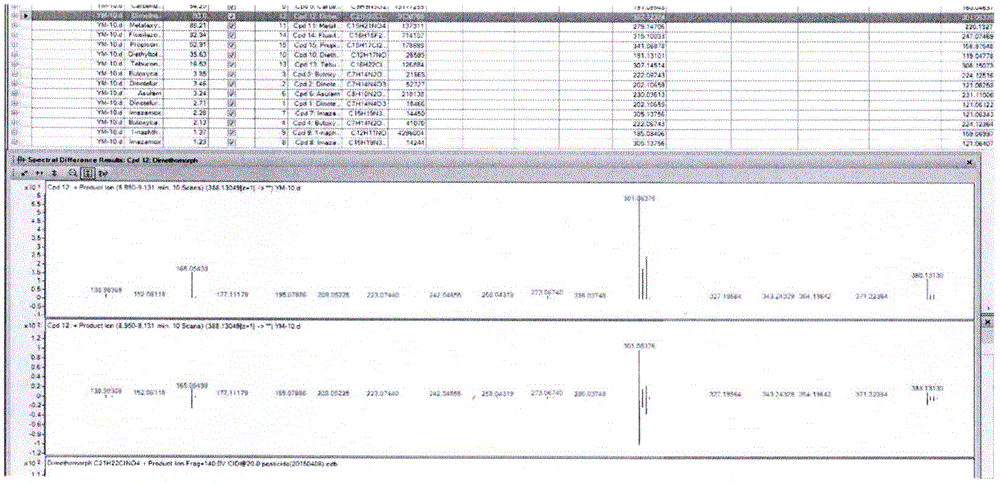LC-Q-TOF/MS detection technology for 544 pesticide residues in stone fruits
A Q-TOF, pesticide residue technology, applied in measuring devices, instruments, scientific instruments, etc., can solve the problems of high price, loopholes in food safety monitoring, and only 2 or 3 years of validity, and achieve the effect of large amount of information
- Summary
- Abstract
- Description
- Claims
- Application Information
AI Technical Summary
Problems solved by technology
Method used
Image
Examples
Embodiment 1
[0066] Implementation example of LC-Q-TOF / MS detection and confirmation technology for 544 pesticides (see Table 1) in stone fruit (taking peach as an example), including the following steps:
[0067] 1. Specific steps of sample pretreatment technology:
[0068] 1.1 Take the edible part of the peach sample, chop it up, mix it evenly, seal it, and mark it;
[0069] 1.2 Weigh 10g of peach sample (accurate to 0.01g), add 40mL of 1% acetic acid acetonitrile into an 80mL centrifuge tube, use a high-speed homogenizer at 13500r / min, homogenize and extract for 1min, add 1g of sodium chloride, 4g of anhydrous magnesium sulfate , shake for 5 min, centrifuge at 4200 r / min for 5 min, take 20 mL of the supernatant, concentrate it to about 1 mL by rotary evaporation in a 40°C water bath, and wait for purification.
[0070] 1.3 in Carbon / NH 2 Add about 2cm high anhydrous sodium sulfate to the column. Rinse the SPE column with 4 mL of acetonitrile + toluene (3+1, v / v) first, and discard th...
Embodiment 2
[0099] Implementation example of LC-Q-TOF / MS detection and confirmation technology for 544 pesticides (see Table 1) in stone fruit (taking apricot as an example).
[0100] The sample pretreatment steps and LC-Q-TOF / MS operating conditions refer to the processing conditions in Example 1.
[0101] Measure the sample solution in full-scan mode, compare the detection results with the TOF database, and obtain the first-level TOF score, see Figure 4 ; For compounds whose scores meet the requirements, establish a secondary acquisition method in the software, see Figure 5 ;In MS / MS mode, re-run the sample solution to obtain the full scan data of the sample fragment ions, compare it with the fragment ion information in the MS / MS library, and obtain the secondary QTOF score, see Figure 6 .
[0102] LC-Q-TOF / MS detection results in apricot samples in a certain area: 7 commercial pear samples were collected in a certain area, and 544 kinds of pesticide residues were detected by LC-Q-...
Embodiment 3
[0106] Implementation examples of LC-Q-TOF / MS detection and confirmation technology for 544 pesticides (see Table 1) in stone fruit (jujube as an example) samples.
[0107] The sample pretreatment steps and LC-Q-TOF / MS operating conditions refer to the processing conditions in Example 1.
[0108] Measure the sample solution in full-scan mode, compare the detection results with the TOF database, and obtain the first-level TOF score, see Figure 7 ; For compounds whose scores meet the requirements, establish a secondary acquisition method in the software, see Figure 8 ;In MS / MS mode, re-run the sample solution to obtain the full scan data of the sample fragment ions, compare it with the fragment ion information in the MS / MS library, and obtain the secondary QTOF score, see Figure 9 .
[0109] LC-Q-TOF / MS detection results in jujube samples in a certain area: 9 commercially available jujube samples in a certain area were collected, and 544 kinds of pesticide residues were det...
PUM
 Login to View More
Login to View More Abstract
Description
Claims
Application Information
 Login to View More
Login to View More - R&D
- Intellectual Property
- Life Sciences
- Materials
- Tech Scout
- Unparalleled Data Quality
- Higher Quality Content
- 60% Fewer Hallucinations
Browse by: Latest US Patents, China's latest patents, Technical Efficacy Thesaurus, Application Domain, Technology Topic, Popular Technical Reports.
© 2025 PatSnap. All rights reserved.Legal|Privacy policy|Modern Slavery Act Transparency Statement|Sitemap|About US| Contact US: help@patsnap.com



